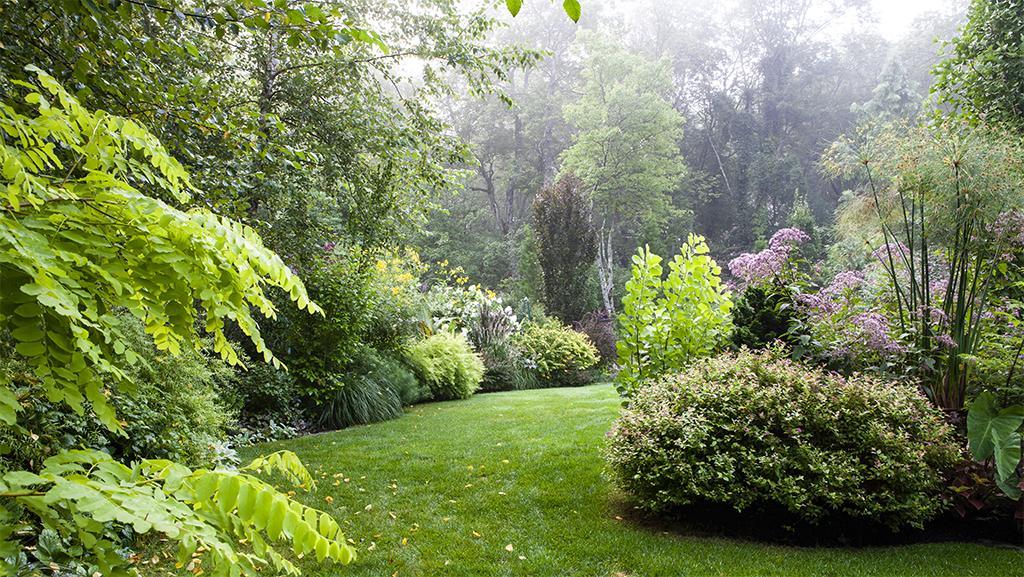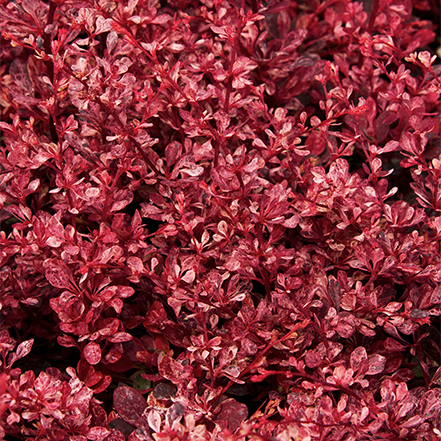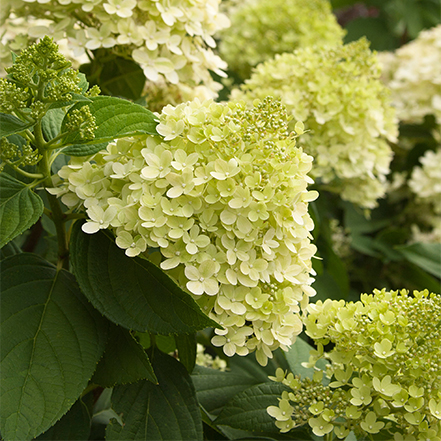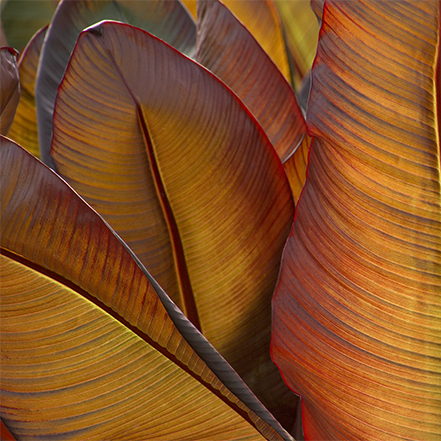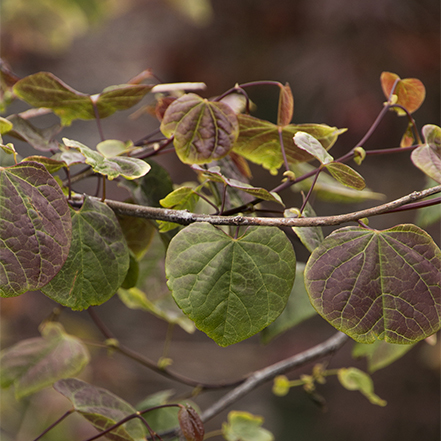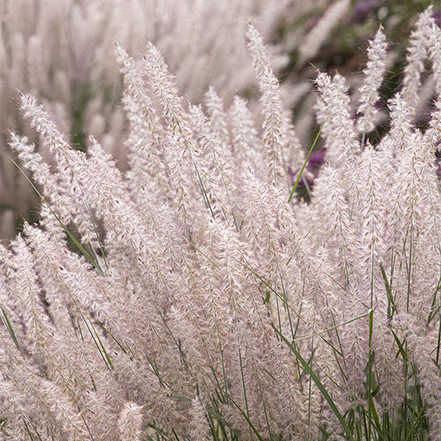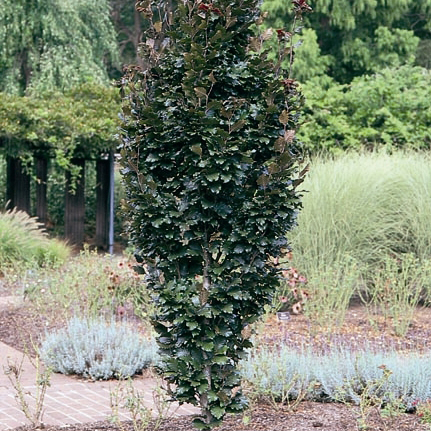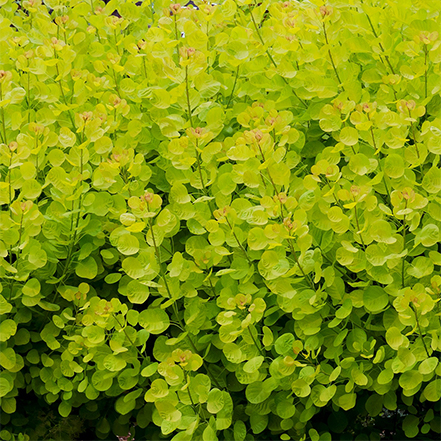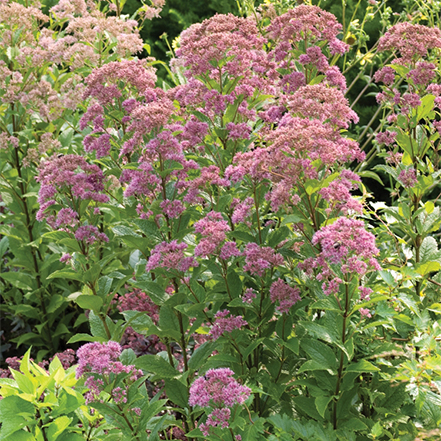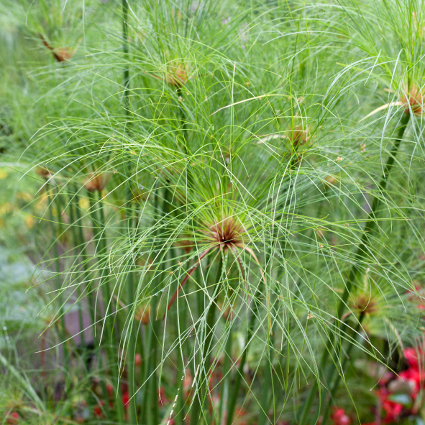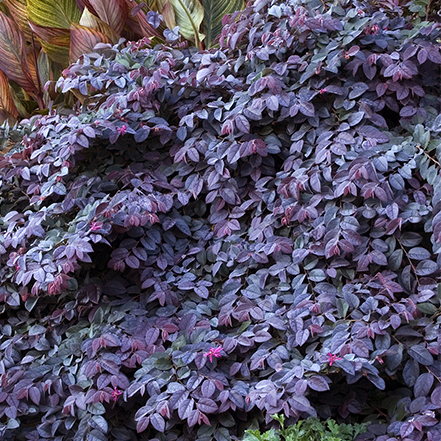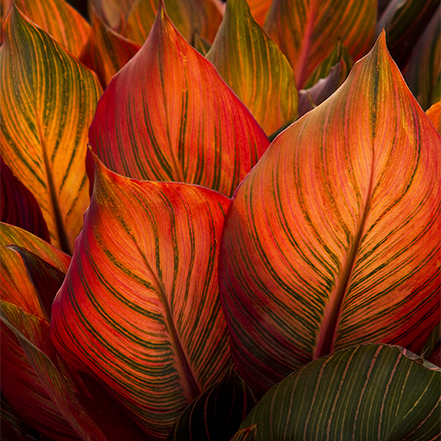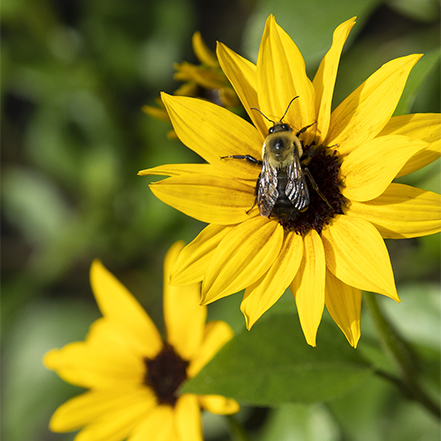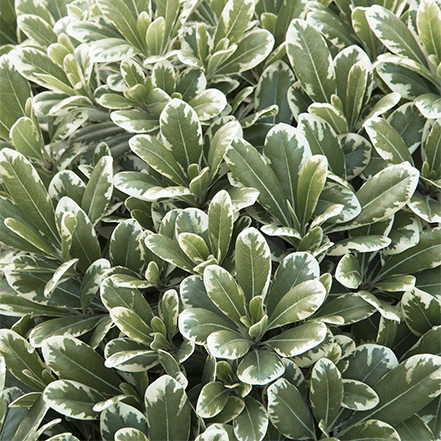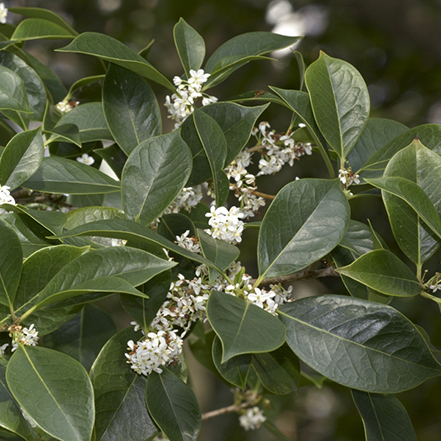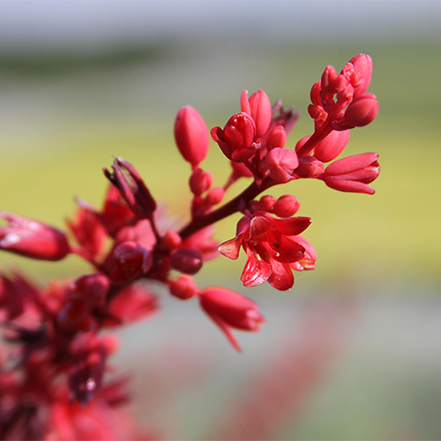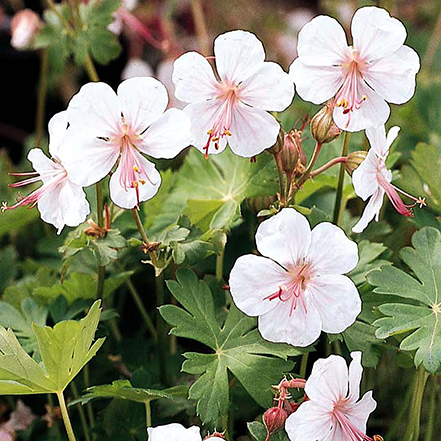If you look at homeowner Ellen Lathi's magazine-worthy paradise of secluded walkways, rustic bridges, fantastic follies, and deep, lush borders and wonder how it is that some people have all the luck, take heart! This zone 6B two-acre lot in a Massachusetts suburb was once a front lawn, a few foundation plantings, and a swampy woodland in the back. Transforming her yard bit-by-bit over the course of twenty years, Ellen let the needs of her growing family, time-crunched lifestyle, and desire for something beautiful but fuss-free, define how this incredible garden came together for family, friends, pets, wildlife, and the gardener herself to enjoy (keep an eye out for Ellen's adorable pets, who make key appearances throughout the post).
If your heart is telling you that your own yard, at whatever stage of landscaping you are in, was meant to be something more—more magical, more sustainable, more fun—read on for "I could do that" design ideas from this beautiful, family-focused garden.
We had a lovely garden chat with Ellen, a neurologist, mother of two, and devoted dog lover who created a spectacular, eclectic garden on a cul de sac in a Boston suburb over the past twenty years. In our conversation, she offers practical garden design tips, fabulous plant recommendations, and a genuine, open-hearted glimpse into how a garden can enrich life.
This colorful border was added to the lawn behind the house. The tall, dense plantings can be seen from the back patio, and screen the mysterious woodland spaces on the other side. (Inspired? See a list of some key plants below.)
PHOTOS: Keller & Keller
PLANT PHOTOS: Doreen Wynja
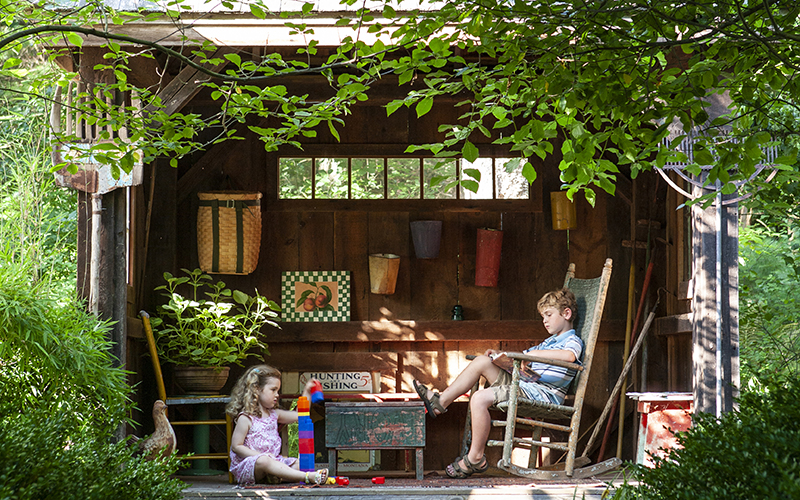
(Above: a three-sided folly —a nonessential building that often serves as a garden focal point—is a popular hangout for visitors to the garden.)
Your garden almost defies definition. It's a fantastic mash-up of ideas and styles and disciplines. When choosing plants what do you take into consideration?
When I was a younger gardener, I would be disappointed when something died. Now I look at it as an opportunity to try something else. I have learned over the years that this is more like a Pacific Northwest garden and I just go with it. I like to mix it up. My focus is building on the differences in leaf color, textures, and size. I have no perennial beds and generally prefer shrubs both evergreen and deciduous. Flowers are beautiful, but transient–I want my garden to look like something year-round.
Your lot is deep and wide with thick woods and even a few streams all of which can be a challenge to landscape. Where did you start to figure out the puzzle?
The garden started when my then young son asked for a playhouse. Rather than simply build it in the backyard, I worked with a builder, Bill McKenny, who thought we should hide the playhouse in the wooded area out back—make it more of an adventure to reach and use. As we chopped through brambles to find the perfect spot, we discovered a swamp which Bill dealt with by building a rustic wooden bridge to reach the other side. On the other side, he found a creek and a stream which were both navigated by two more bridges and finally led to a pine grove where we built the playhouse.
So that's the story behind all of these whimsical elements.
Yes, this started as a project for my son but in the end, it’s all for me. I eventually added the folly and then built a patio off the back of the house that I use all the time. Nothing that happened in the garden was really planned and I never predicted I would love gardening. It's just about pleasure. And that is what gardening should be.
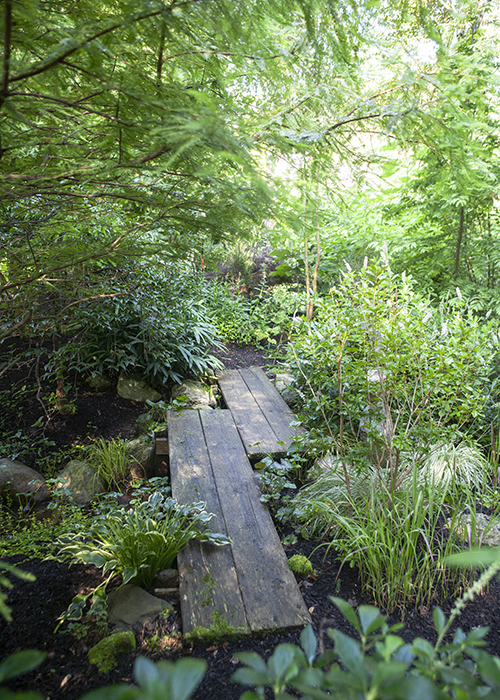
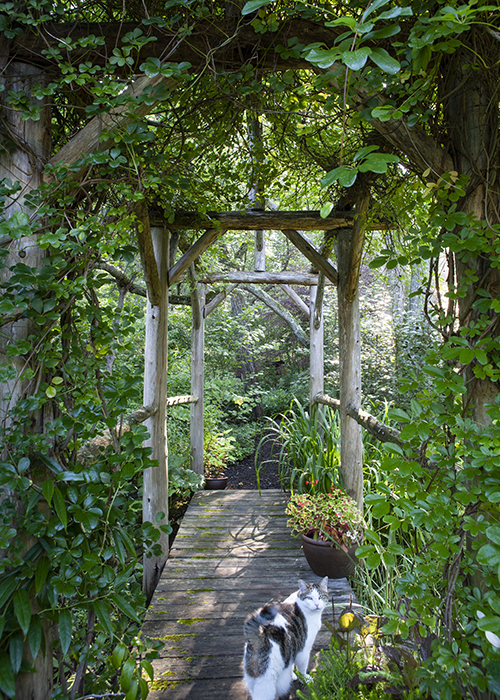
Above: A zigzag bridge, inspired by Japanese garden design, spans a stream that permits access to the far reaches of the garden (right). One of three rustic, hand-hewn bridges leads visitors through the garden. That's akebia, a fragrant-flowered vine, scrambling over the top and primroses and grass-like sweet flag along the path (left).
We are mesmerized by all of the tropicals in your zone 6B garden. What's the story there?
I love the foliage you can find in tropical plants and like to have them layered into my front and back gardens. Bananas, red and green Cordylines, Canna, papyrus, Abutilons, Agave, and ferns—all of them! They are either planted in the ground or left in plastic pots which are sunk into the ground. As most are frost-sensitive, in late October they are removed from the garden and either discarded or replanted into terra cotta pots and stored overwinter in a nearby greenhouse I rent. We move them back to the garden in early May. I've been doing this for years. It's a lot of work! Every year I say I won’t do this anymore, but in August when everything is big and leafy and gorgeous I say, "okay one more year."
Your garden has a focus on foliage that translates to a lush, enchanting experience. What advice do you have for gardeners who love this look?
My best advice about designing a garden is to just start looking around. I lived in my house forever and did nothing to the garden. Then I would be out and about and started to notice things that I wanted to try and grow. I initially worked with a designer and then started reading books and taking classes, but figured out my own garden by watching and learning, seeing gardens, and thinking "what can I do with that?" I did it myself because I wanted to be responsible for my mistakes and victories.
Aside from some clematis and hydrangeas, my garden is mostly foliage. In terms of designing a garden centered around foliage, you need to think in extremes—you want very large and very small leaves so that each plant stands apart.
When it came to my garden, one thing I wanted was to be able to look out every window of the top floor of my house and see a different tree. Talk about foliage! I planted five different trees, including golden metasequoia, magnolias, umbrella pines, and Stewartias, in different spots and now have living curtains with lots of privacy.
Tell us about a time when things didn't go exactly according to plan?
I have three dogs and plenty of critters, so just about everything is on the menu. Plus winters in New England can be rough. At one time, I had 75 hostas, each of which I could name, that disappeared. And my dogs stripped the bark from my birch trees. I am also guilty of planting too close and too much and have had to remove my share of plants.
What advice would you give a gardener just starting out and on a smaller budget?
I started with a single project and built out the garden over time. Decide what you "need" rather than "want" and let that be your guide. And buy the best plants you can afford even if it means landscaping a small area, but doing it well.
Clearly, this garden is personal. What does it mean to you?
For me, gardening is an essential, extraordinary experience. There is nothing like that connection with the earth. It changes you. My garden is very accessible. An average suburban lot that I made special. And a partnership with nature that makes it even more meaningful. All I really need is my family, my dogs, and my garden.
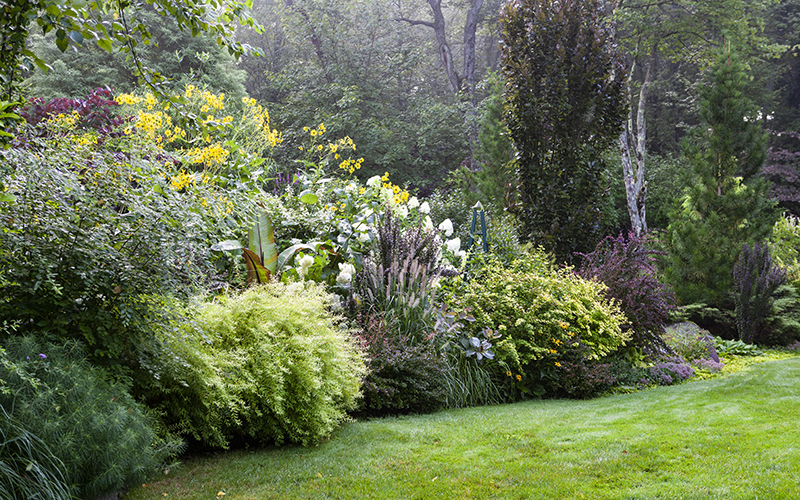
6 Key Plants in This Billowy Border
The sweeping border pictured above is behind the house, and the plant combinations define the entire design of this garden. Wondering what's in this wonderful border? Here are some of the key plants. Also in this border are Arkansas Bluestar (Amsonia hubrichtii) on the lower left, Ogon Spirea (Spirea thunbergii), and Bonanza Gold barberry (Berberis thunbergii) on the far right. That amazing tall yellow flowering one in the back? That's Silphium perfoliatum, native to North America. It's also called "cup plant" (If you can't find it, try Helenium instead).
Rose Glow Japanese Barberry
Rose-red foliage mottled with white and green in spring on arching branches. Full sun. Up to 5' tall, 4' wide. Zones 4 - 8.
Limelight
Hardy Hydrangea
Huge green flowers open mid-summer turning pink and red in fall. Full to partial sun. Up to 8' tall and wide. Zones 3 - 9.
Red Leaved
Banana
Bold-colored foliage in wine-red and bronze with prominent venation. Shelter indoors for winter in cold zones. Full sun. Up to 15' tall. Zones 10-11.
Ruby Falls
Weeping Redbud
Compact redbud tree with a weeping canopy for a smaller-sized landscape. Full sun. Up to 8' tall, 6' wide. Zones 5 - 9.
Karley Rose
Oriental Fountain Grass
Smoky-purple flower spikes; longer bloom season and greater cold tolerance. Full sun. Up to 4' tall and wide. Zones 5 - 10.
Red Obelisk
European Beech
Naturally columnar with deep purple, crinkled foliage. Full sun. Up to 12' tall, 3' wide; 40' tall with age. Zones 4 - 7.
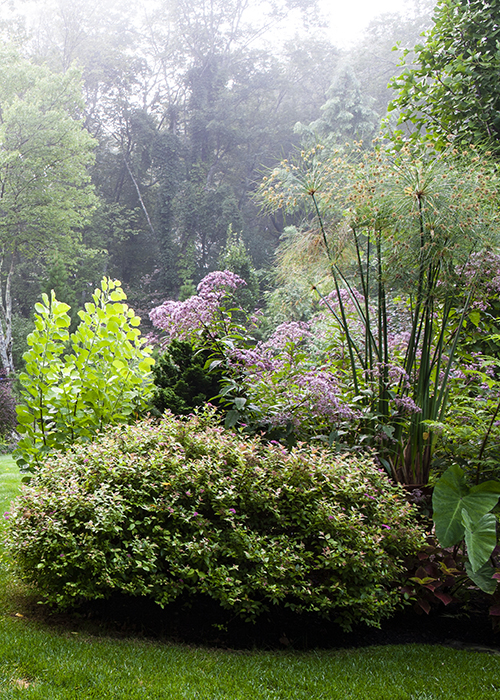
IT'S IN THE DETAILS:
Even in a garden with large, sweeping borders and statement-making elements, the small moments jump out. Ellen created this interesting plant cluster above the lawn that separates this grouping from the larger border pictured down below (just look for the cute dog). Playing with height, scale, and texture, this combination of sturdy shrubs, evergreens, tropicals, and natives has it all. The papyrus will be chopped to the ground, lifted out, and stored indoors for the winter. The pretty flowering shrub in the foreground is Goldmound Spirea. Look around your own yard for a spot where a group of plants could really shine and then try mixing and matching.
3 Key Plants in This Grouping
Golden Spirit Smoke Tree
Outstanding three-season specimen. Airy, pale pink flowers in summer. Full sun. Up to 8" tall, 6' wide. Zones 4 - 8.
Dwarf Joe Pye Weed
Mauve-purple, dome-shaped flower heads bloom from late summer to early fall. Full to partial sun. Up to 4' tall and wide. Zones 4 - 8.
Papyrus
Frost sensitive tropical with feathery heads on green stalks. Shelter indoors for winter in cold zones. Full sun. Zones 9 - 11.
Live in a warmer zone but love this vibe? Here are some suitable swaps to consider.
Sizzling Pink
Fringe Flower
Clusters of fringed flowers bloom throughout the year on the graceful shrub. Full sun. Up to 6' tall, 5' wide. Zones 7 - 9.
Tropicanna®
Canna
Exotic multi-colored foliage on tall stems crowned by large, bright orange blooms. Full sun. Up to 5' tall, forming clumps 4' wide. Zones 7 - 11.
SunBelievable® Golden Girl Helianthus
Multi-branching annual produces over 1,000 flowers in a single season. Full sun. Up to 32" tall and wide. Zones 2 - 11.
Cream De Mint™Dwarf Pittosporum
Variegated leaves are perfect for the front of the border where you need oomph, not height. Full sun. Up to 30" tall. Zones 8 - 11.
Sweet Osmanthus
Ideal back of the border evergreen shrub with those famously fragrant tiny flowers. Full sun. Up to 10' tall, 8' wide. Zones 8- 11.
Brakelights®
Red Yucca
Add a curveball to a border with prolific red flowers over an exceptionally long season. Full sun. Up to 2' tall and wide; blooms to 3' taller. Zones 5 - 10.
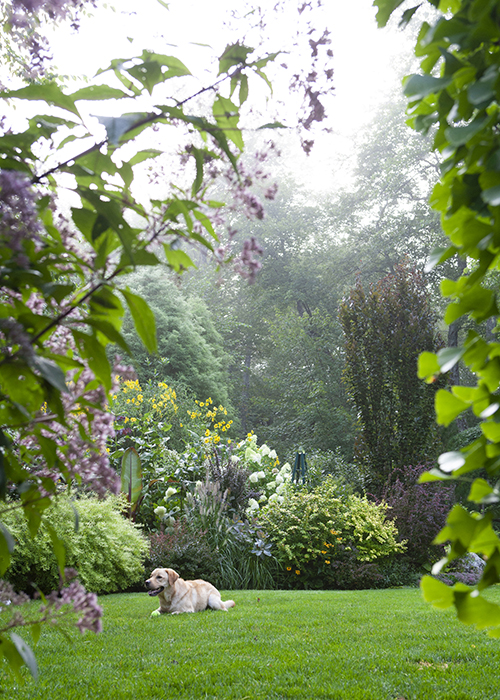
WHAT SHE KNOWS:
“Every year you need to make choices in the garden. I pull plants out, move things around, plant something new,” Ellen says of her now mature garden. "Things get too big or they don't work or I just find something I want to try. That's part of the fun of having a garden."
"And I learned to work with what I have," she continues. "My garden soil is more wet than dry, there is a lot of shade from mature trees and behind the border are more swampy spaces with paths to navigate them. So, the things I grow best like damp shade. I select plants that I know will thrive there. And when they do well, I plant many more. Astilbe, Epimedium, Camassia, ferns, Leucojum, primrose, Solomon’s Seal are just a few of the plants I love to grow."
(Oh, that's sweet Cooper holding court to the left!)
Ellen's Current Plant Passions
Like any true plant-lover, Ellen is always trying something new in her garden. Here are just a few of her most recent additions.
Sunset Glow
Clumping Bamboo
Excellent choice for screens. Full sun. Upright stems reach 8 ft. tall; clump only expands 2 to 4" per year. Zones 5 - 9.
Autumn Moon
Fullmoon Maple
New growth unfurls yellow to burnt orange. Thrives in cool summer regions. Full sun. Slow growing to 12' tall, 8' wide. Zones 5 - 7.
Fanal
Astilbe
Tall garnet-red blooms with a light, airy quality rise above graceful mounds of bronze-green foliage. Partial shade. Up to 2' tall and wide. Zones 4 - 9.
Biokovo
Cranesbill
Flowers from late spring into summer. Fragrant foliage becomes red-tinged in fall. Full to partial sun. Up to 10" tall, 3' wide. Zones 4 - 8.
River
Birch
Buff-colored peeling bark is a wonderful backdrop for yellow fall color. Thrives in moist areas. Full sun. Up to 40' tall and wide. Zones 4 - 7.
Pyramidal
European Hornbeam
Plant in groups as a screen or windbreak, or use as a specimen in a narrow yard. Full sun. Up to 45' tall, 35' wide. Zones 4 - 8.
5 Top Takeaways
-
Start with a purpose: Ask yourself what do I "need." Whether creating a vegetable garden, patio, privacy hedge or in this case, a playhouse for her young son, let a good reason give you a kick-off point.
-
Expand the plant palette: While you are likely to have core plants that you love and know will perform well in your climate, expand your range with native, tropical, or just the unexpected. Ellen has to lift out and store her tropical plants but wow, the impact!
-
Foliage over flowers: Expert opinions may vary of course, but aiming for a ratio of two-thirds of the plants in a garden selected for their foliage and the remaining one-third of plants chosen for their flowers will help ensure beauty over a long period.
-
Build over time: It is tempting to over-plant, but it only gets you into trouble (we all know this and do it anyway!). Ellen took her time building this garden, letting the magic of season after season fill the space so it looks natural.
-
Color scheme: Ellen's garden is a constrained grouping of green, yellow, and purple. This leads to the "there's just something about it" peaceful and relaxed harmony you see here.
Learn More
- Browse the blog for more garden design tips.
- See our entire assortment of plants for your garden.
- For more inspiration and information, please subscribe to our monthly newsletter.
- Find a Monrovia retailer here.
Related stories:
How to choose the best landscape shrubs
Plants to add 6 months of color to your garden
Learn about panicle hydrangeas




